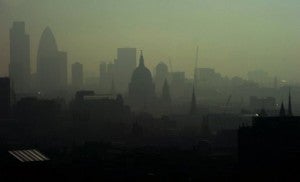This commentary was originally posted on the EDF Texas Clean Air Matters Blog.
As we continue seeking relief from rising temperatures this month, it’s also time to be on the watch for ozone alerts. The annual Texas smog season – April 1 through October – already appears to be in full swing this year with numerous counties around the state exceeding health-based ozone concentrations many times since March.
Just last week, the Houston Chronicle highlighted the magnitude of ozone exceedances that the area hasn’t seen since 2003. Additionally, the month of May was the nation’s “smoggiest” in the past five years according to a recent report released by Clean Air Watch. Texas ranked second, surpassed only by California, for the most Code Red and Code Orange days so far in 2012, with 18 days and 27 days respectively.
Ozone-forming pollution is emitted by cars, refineries and various industrial plants. As more Texans begin to see shale gas drilling rigs pop up around them, many are asking the question: Could emissions from natural gas and oil operations significantly contribute to ground-level ozone? The answer is an unequivocal yes.
The Role of Natural Gas and Oil in Rising Ozone Levels
While burning natural gas produces less smog-forming pollution than coal combustion but more than renewable energy generation, much of the equipment used in the drilling, production, processing and transporting of natural gas and oil produces significant amounts of such pollution. This equipment releases volatile organic compounds (VOCs) and oxides of nitrogen (NOx), which combine in the presence of sunlight to form ground-level ozone or “smog.” According to the state of Colorado, natural gas and oil operations were the largest source of ozone-forming pollution, VOCs and NOx in 2008.
The Texas Commission on Environmental Quality has reported that storage tanks used in the exploration and production of natural gas and oil are the largest source of VOCs in the Barnett Shale. Recently, there have been additional concerns that San Antonio may not meet federal ozone standards due to Eagle Ford Shale development. Peter Bella, natural resources director at the Alamo Area Council of Governments, told the Houston Chronicle that the city is “right on the edge of nonattainment.”
Ozone concentrations comparable to those recorded in some of the most heavily polluted U.S. cities have been measured in rural parts of Wyoming and Utah, where little other industrial activity occurs:
- In 2010, air quality exceeded national health standards for ozone nearly seventy times in Utah’s Uintah Basin. Concentrated natural gas and oil development in the Uintah Basin has been identified by the Bureau of Land Management (BLM) as the primary cause of the ozone pollution.
- Residents of Wyoming’s Upper Green River Basin suffered thirteen unhealthy ozone days in 2011. Air quality in the Basin had declined so much due to emissions from natural gas activities that former governor Dave Freudenthal requested it be designated an ozone nonattainment area, which the Environmental Protection Agency (EPA) confirmed.
It’s important to note, however, that ozone monitoring does not exist in many oil and gas development areas, so we don’t know the full extent of the potential problem. For instance, though the Texas Commission on Environmental Quality has committed to start monitoring in the Eagle Ford, there is not currently sufficient monitoring to characterize ozone problems in the area.
Protection of Human Health
As natural gas and oil development expands into new regions, adverse air impacts are likely to follow, absent sufficient emissions controls. It is crucial for states to have strong standards in place, especially for a state such as Texas, which experienced exponential production increases in a short period time. The Eagle Ford Shale alone saw a 432 percent increase in natural gas production from 2010 to 2011.
We are happy to report that EPA recently finalized clean air measures that will serve as an important first step in reducing harmful pollution discharged from a variety of oil and natural gas activities. In fact, last month, EDF President Fred Krupp testified before the U.S. Senate in support of these new clean air standards, which will result in significant reductions in smog-forming pollutants and hazardous air pollutants like benzene, a known carcinogen. As a co-benefit, the standards will also reduce methane, a potent climate forcer.
In his testimony, he said “these common sense measures are a win-win: they reduce pollution, conserve valuable domestic energy resources, and in some cases, actually save producers money.” He added that it was “critical that we build on these clean air measures if our nation is to fulfill the President’s promise in his State of the Union to develop natural gas without putting the health and safety of our citizens at risk.”
While mounting evidence continues to link natural gas drilling with rising ozone levels, it is important to remember why we should care in the first place:
- Ozone has been linked to a host of maladies, including premature mortality, heart failure, increased hospital admissions and emergency room visits for respiratory causes among children and adults with pre-existing respiratory disease, such as asthma and inflammation of the lung, and possible long-term damage to the lungs.
- Children, the elderly, and people with existing respiratory conditions are the most at risk from ozone pollution.
- Ozone also damages crops and ecosystems. Ozone is one of the most phytotoxic air pollutants – causing damage to vegetation in national parks and wilderness areas, especially in mountain regions and to valuable crops.
- Ozone pollution also contributes to climate change. According to the Intergovernmental Panel on Climate Change (IPCC), ozone is the third-largest contributor to climate change after carbon dioxide and methane.
In the end, we’re talking about the protection of human health as well as our entire planet. Continue to visit this blog for updates on rising ozone levels in our state, as well as other vital information related to Texas air quality.










